Auschwitz-Birkenau |
||
|
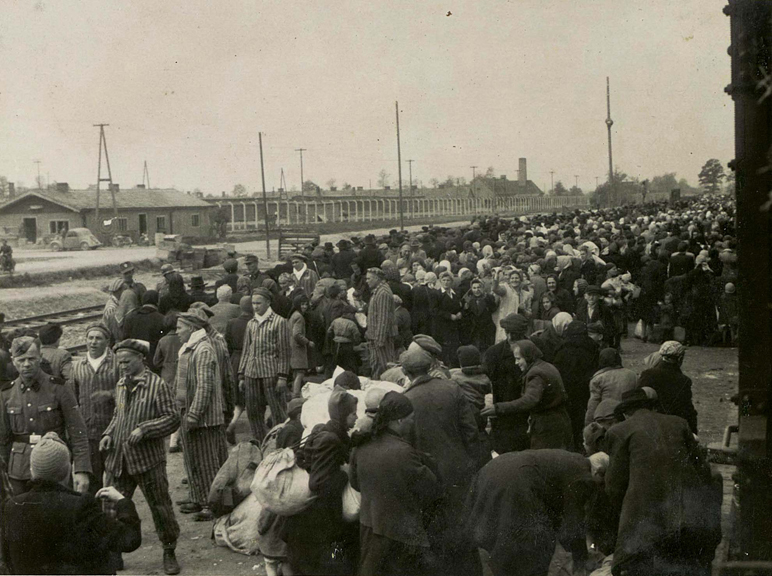
Auschwitz-Birkenau |
||
|

|
Auschwitz is a name that was virtually unknown before 1989. Now it has become a symbol for The Holocaust -- the Nazi plan to systematically exterminate all the Jews of Europe, which resulted in the deaths of 6 million Jews. Auschwitz is the site of the greatest mass murder of all time, the most infamous Nazi death factory, the primary killing site where the "Final Solution to the Jewish Question" was carried out by means of homicidal gas chambers, the most heinous place on earth. An estimated 1.3 million victims arrived at Auschwitz between June 1940 and January 1945 and 1.1 million of them died there, including over 900,000 Jews. Today there are around one and a half million visitors who tour Auschwitz-Birkenau each year. The world first learned that the Jews were being gassed at Auschwitz when resistance fighters in the Polish Underground passed this information on to the Polish government in exile in Great Britain. On June 25, 1942, The Telegraph, a British newspaper, ran a story about the mass murder of Jews in gas chambers at Auschwitz. The headline read "Germans murder 700,000 Jews in Poland." According to this first report, which was also broadcast on the radio by the British BBC in June 1942, a thousand Jews a day were being gassed. 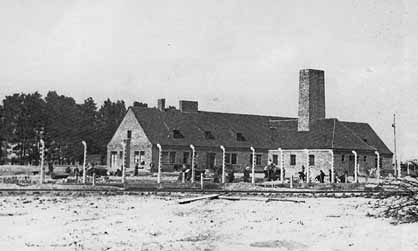 Auschwitz is more than one place: it is a small town in what is now Poland, but the name Auschwitz also refers to three separate prison camps called Auschwitz I, Auschwitz II and Auschwitz III, all of which were located just outside the town. The Auschwitz complex was an extermination camp, a labor camp, a transit camp and a concentration camp, all rolled into one. Auschwitz I was the main camp; it was a Class I concentration camp, which was opened in June 1940 in the barracks of a former Polish Army garrison. The first prisoners were mostly non-Jewish Polish political prisoners, but a few Jews were also imprisoned there. Auschwitz II was the death camp where over a million prisoners, mainly Jews, were killed, mostly in gas chambers; today, it is the world's largest Jewish graveyard, the place where the ashes of innocent victims were scattered over the fields, thrown into the rivers, or dumped into several small ponds sixty five years ago. Auschwitz III was a work camp where prisoners worked in the factories of the I.G. Farben company, along side civilian workers who were not prisoners. The town of Auschwitz, which was originally founded by Germans in 1270, is now known by its Polish name, Oswiecim, and the three camps are known as Auschwitz, Birkenau, and Monowitz. The Polish name for Birkenau is Brzezinka and Monowitz is called Monowice by the Poles. In June 2007, the United Nations officially changed the collective name of the three Auschwitz camps to Auschwitz-Birkenau, German Nazi Concentration and Extermination Camp (1940-1945). This change was made at the request of the government of Poland so that people will know that Poland had nothing to do with setting up the camps or running them. The size of the Auschwitz "Zone of Interest" was 40 square kilometers. There was a security zone, consisting of 5,000 acres of potential farmland, which Reichsführer-SS Heinrich Himmler, the head of the SS and all the concentration camps, eventually turned into a huge farm where 10,000 inmates, mostly women, were put to work. This was an agricultural experiment station for the benefit of the German farmers who were brought to the region to settle on farms that were taken away from the Polish inhabitants. Himmler, who is sometimes dismissed as a "chicken farmer" had a degree in Agriculture and Rudolf Hoess, the first Commandant of Auschwitz, was previously a farmer. The photo at the top of the page was taken on May 26, 1944 when Hungarian Jews were brought to the Auschwitz II extermination camp, also known as Birkenau. In the photo, the prisoners in striped uniforms, wearing white scarves, were with the Kanada Kommando, which was in charge of collecting the luggage from the incoming trains and taking it to the clothing warehouses. The location of the clothing warehouses was called Canada, or Kanada in German, because of the great wealth to be found there, including fur coats, diamonds and even pots and pans and canned food that had been confiscated from the luggage of the Jews. Across the road from Canada at the Birkenau camp was the Sauna building where the clothing was disinfected in steam chambers. There was also a shower room in the Sauna building. In the photo above, you can see Crematorium II with its tall chimney on the right side in the background. Up to 12,000 Jews per day were murdered upon arrival in the gas chambers at Birkenau and their bodies were burned in the ovens in the crematoria. According to Robert Jan van Pelt, a noted Holocaust historian, there were 500,000 Jews gassed in the underground gas chamber in Crematorium II, called Krema II by the Germans. The total number of Jews gassed during the Holocaust, as stated in a display at the Wannsee Museum in Berlin, is 3,652,000. This incudes the Jews who were gassed at Chelmno, Treblinka, Belzec, Sobibor and Majdanek, as well as Auschwitz-Birkenau. Note the absence of German guards with guns or dogs in the photo above; at this point, the new prisoners did not yet know what their fate would be. Note that there is no smoke coming out of the chimneys of the crematoria. In the center background of the photo, the concrete posts for the barbed wire fence around the barracks can be seen, but notice that there were no guard towers along the whole length of the main camp road. Guard towers have since been added. On July 2, 1947, what is left of the Auschwitz camps became the Auschwitz Museum, by an official decree which stated: "...on the site of the former Nazi concentration camp, a Monument of the Martyrdom of the Polish Nation and of Other Nations is to be erected for all times to come." Note that there was no mention of the Jews in the decree. Poland was, at that time, a Communist country under the domination of the Soviet Union, which did not recognize any religion. The Monowitz camp, once located on the east side of the town of Auschwitz, is no longer in existence, although the Buna Werke factories, once owned by the I.G. Farben company, were taken over by the Poles and are still in use today. It was at Monowitz that famous Auschwitz survivors Primo Levi and Elie Wiesel once worked. Both Levi and Wiesel wrote extensively about their suffering at Auschwitz, but for years after the war, no one was interested. When Primo Levi took his first manuscript, "Se questo è un uomo," to an Italian publisher in 1946, it was completely rejected. At that time, it was not Auschwitz that was the focus of the Nazi Crimes against Humanity, but rather Dachau and Buchenwald. Oswiecim is now a factory town with 50,000 residents, but before the German invasion of Poland on September 1, 1939, it was a market town with a population 12,000, of which 7,000 residents were Jewish. The next largest ethnic group in Oswiecim in 1939 was the Roma (Gypsies). The Jews, who had lived for over 500 years in the town, which they called Oshpitzin, were evacuated by the Nazis to three different ghettos in 1941, but eventually ended up back at Auschwitz, where most of them perished in the death camp. A few Jewish survivors came back to the town after the war, but soon left for Israel or the United States. At one time there were more than 12 Synagogues in Oshpitzin, but all except one were destroyed by the Nazis. The one surviving Synagogue, originally opened in 1930, has been reconstructed and since the year 2000, it has been open for tourists. The area of Europe that was inhabited by the German tribes in the Middle Ages became the Holy Roman Empire in the year 800 and by 1270, the Empire had expanded to include the area known as Upper Silesia, where Auschwitz is located. In 1457, Auschwitz became part of the Kingdom of Poland and it was then known as Oswiecim. Most of Silesia was annexed to the German state of Prussia in 1742, except for four duchies. The duchy of Auschwitz was annexed to Galicia, a province which was given to Austria when Poland lost its independence in 1772 and the country was divided between Russia, Prussia and Austria. Western Galicia soon became known as The Corner of Three Empires: Russia, Prussia and Austria. The town known as Auschwitz, or Oswiecim or Oshpitzin, became a prime location for Jewish traders or merchants during the time that Galicia was part of the Austro-Hungarian empire. In 1871, Prussia and the other German states, except Austria, united into the country of Germany. After the defeat of Germany and Austria in World War I, Galicia and the industrial area known as Upper Silesia were given to Poland. In 1939, after the joint conquest of Poland by Germany and the Soviet Union, Upper Silesia was annexed into the Greater German Reich, which at that time consisted of Germany, Austria and the Sudetenland in what is now the Czech Republic. 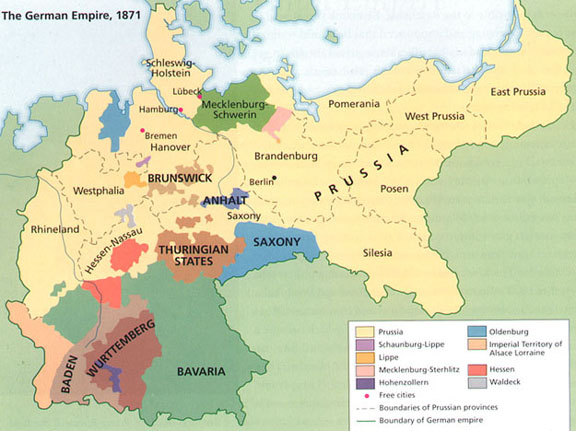 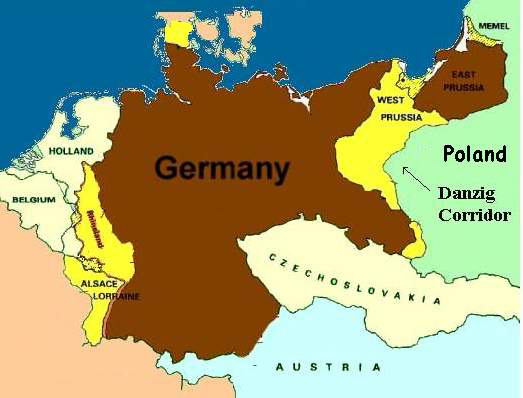 The map shown above is what was left of Germany after German territory was given to other countries in the terms of the Treaty of Versailles after the end of World War I. Hitler blamed the Jews for the German defeat in World War I and for the harsh terms of the Treaty of Versailles. World II started with the German invasion of Poland, followed by the annexation of Silesia into the Greater German Reich. Auschwitz was located in Silesia. When railroad lines were built in the 19th century, the little town of Auschwitz, at the junction of three empires, became the crossroads of Europe. There were 44 train lines coming into Auschwitz, making it at one time a larger railroad hub than Penn Station in New York City. It was because Auschwitz was such an important railroad junction that a camp for migrant workers was built in a suburb of the town in 1916; seasonal farm workers from all over Europe were sent from Auschwitz to the large German estates. The migrant worker camp, with its beautiful brick barracks buildings, was the place that eventually became the Auschwitz I concentration camp. In 1919, Poland became an independent country again and Auschwitz became a Polish town called Oswiecim. The former migrant worker camp was used as a garrison by the Polish Army. The Auschwitz main camp originally had 20 brick barracks buildings; 14 of them were single story buildings and 6 were two stories high. When this camp was converted into the Auschwitz concentration camp, a second story was added to the 14 single story buildings and 8 new two-story buildings were added, making a total of 28 barracks buildings. Between 13,000 and 16,000 concentration camp prisoners were crowded into these 28 buildings where they slept in three-tiered bunks. At one point, in 1942, there were 20,000 prisoners at the Auschwitz main camp. Germany invaded Poland on September 1, 1939 and the town of Oswiecim was captured on September 6th. Following the conquest of Poland, the name of the town reverted back to Auschwitz. The city of Krakow, located 37 miles from Auschwitz, became the capital of German-occupied Poland, known as the General Government. It is important to note that, during the time that Auschwitz was a killing center, it was in the Greater German Reich, not in occupied Poland. The Polish people are incensed when Auschwitz is described as a concentration camp in Poland. Auschwitz was located literally at the junction of the Greater German Reich and occupied Poland; it was also in the heart of "The Black Triangle," an industrial area with large coal deposits, which is why it was such an important location for the Nazis. 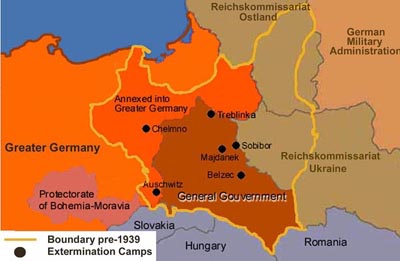 The genocide of the Jews did not officially start until after the Wannsee Conference, held on January 20, 1942, where the plans for the "Final Solution of the Jewish Question" were finalized. The conference was led by Reinhard Heydrich. The exact date of Hitler's order to exterminate the Jews is unknown, but an order from Hermann Goering to Reinhard Heydrich on July 31, 1941 reads as follows: Complementing the task already assigned to you in the directive of January 24, 1939, to undertake, by emigration or evacuation, a solution to the Jewish question as advantageous as possible under the conditions at the time, I hereby charge you with making all necessary organizational, functional, and material preparations for a complete solution of the Jewish question in the German sphere of influence in Europe. Insofar as the jurisdiction of other central agencies may be touched thereby, they are to be involved. I charge you furthermore with submitting to me in the near future an overall plan of the organizational, functional, and material measures to be taken in preparing for the implementation of the aspired final solution of the Jewish question. On June 22, 1941, Germany invaded the Soviet Union, and by the time that the Wannsee Conference took place, German troops had "liberated" Estonia, Latvia, Lithuania, Belarus and the Ukraine from the Communist Soviet Union. The eastern one third of Poland, which was across the Bug river from the General Government, had been a province of the Soviet Union since the conquest of Poland in September 1939; in January 1942, this area was now under the control of the Germans. Between 1836 and 1917, the area east of the Bug river belonged to Russia and it was known as the "Pale of Settlement." The Czar of Russia had confined the Jews in the Pale of Settlement in 1836; the Russian Jews were finally liberated during the Communist Revolution. After the German conquest of this area in June 1941, millions more Jews were now within the grasp of the Nazis. By December 1941, the German Army had advanced 1,000 kilometers into Russia. The Nazis believed that they were on the verge of winning the war against the Communist Soviet Union and it was time to begin their diabolical plan to exterminate (ausrotten) the Jews of Europe. After the Wannsee Conference, three death camps, called the Aktion Reinhard camps, were set up along the Bug river on the eastern border of the General Government; these three camps were Treblinka, Belzec and Sobibor. The headquarters of Aktion Reinhard was in eastern Poland in the city of Lublin, near the Majdanek death camp. The most conservative estimate of the number of Jews gassed, using carbon monoxide, during 1942 and 1943 in the Aktion Reinhard camps is 1.5 million, the figure given by Raul Hilberg in his 3-volume classic entitled "The Destruction of the European Jews." The bodies were first buried, then dug up and burned on pyres. The round-up of all the Jews in Nazi occupied Europe did not begin until after February 1942 when millions of Jews were deported to the Aktion Reinhard camps and they never returned. Up until that time, many Jews had been sent to Dachau and other camps, but not just because they were Jews. The first Jews were sent to concentration camps because they were Communists, or Social Democrats, or labor union leaders, or homosexuals, or race-mixers who had broken the Nuremberg law against having sex with an ethnic German. It was in February 1942 that the plan to annihilate the Jews of Europe was first implemented, although the murder of Jews in gas vans had already started on December 6, 1941 at Chelmno, shortly before the Wannsee Conference, which had been originally scheduled for December 9th. The first transport of male prisoners to Auschwitz, that consisted entirely of Jews, arrived from Slovakia in February 1942. A transport from France, which consisted of Jewish refugees without French passports, arrived on March 23, 1942. The first Jewish women sent to Auschwitz were on a transport of 1,000 women, between the ages of 16 and 30, from Poprad in Slovakia, which arrived on March 26, 1942. On that same day, 999 women were transferred from the women's camp, in the Ravensbrueck Concentration Camp, to Auschwitz. Most of them were criminals and "asocials," but there were also between ten and twenty political prisoners among them. The plan to establish a concentration camp at Auschwitz was first announced by Reichsführer-SS Heinrich Himmler on April 27, 1940. Konzentrationslager Auschwitz, the main camp, was originally opened on June 14, 1940, as just another concentration camp, in the former Polish military garrison in Zazole, a district of the town of Auschwitz. Thirty German criminals, who were prisoners in the Sachsenhausen concentration camp, were brought to Auschwitz in May 1940 to convert the garrison into a prison camp. Throughout its existence, the Nazis called Auschwitz a concentration camp, not an extermination camp or Vernichtungslager. The term "extermination camp" was coined by the Allies and initially, it applied to all the Nazi camps. At first, the Auschwitz main camp, known as the Stammlager, was only a camp for Polish political prisoners, including some Jews, and also German common criminals, who assisted the Nazis in supervising the other prisoners. The first transport to the main Auschwitz camp consisted of 728 Polish inmates of the Gestapo prison at Tarnow, Poland. They were mostly university students, including a few Jews, who had joined the Polish Resistance. The Polish Army had never surrendered to the Germans and no Armistice had ever been signed. The Poles continued to fight during World War II, but as insurgents or illegal combatants, not as soldiers on the battlefield. When captured, the Polish resistance fighters were sent to Auschwitz or other concentration camps such as Buchenwald and Dachau. Among the first 728 prisoners who arrived at Auschwitz on June 14, 1940 was 18-year-old Wladyslaw Bartoszewski, who later became Poland 's foreign minister and a pioneer of German-Polish reconciliation. Bartoszewski recalled in his memoirs that guards herded the prisoners through the gate with the German inscription "Arbeit Macht Frei." (Work makes Free) "I felt relieved - it seemed like encouragement," he wrote. Source: Gulf Times website Bartoszewski fell seriously ill and was released a half-year later, thanks to intervention by the Red Cross. The first Commandant of Auschwitz was Rudolf Hoess, who is sometimes confused with Hitler's deputy, Rudolf Hess. Hoess is the English spelling of the German name Höß or Höss. Hoess was an officer in Hitler's elite army called the SS; he had received his training at Dachau and had then been assigned to the Sachsenhausen camp before becoming the Commandant of Auschwitz in May 1940. After the war, Hoess was hunted down and arrested by the Jewish Brigade in the British Army. He testified as a defense witness for Ernst Kaltenbrunner at the Nuremberg IMT; Kaltenbrunner was charged with committing Crimes Against Humanity but Hoess testified that Kaltenbrunner didn't know about the gassing of the Jews since he had never visited Auschwitz, which Hoess freely admitted was a death camp. Hoess was later extradited to Poland to stand trial himself. He was convicted and subsequently hanged on April 16, 1947 in front of the Gestapo building at Auschwitz which was right next to the Krema I gas chamber in the main camp. Hoess was the one who put the "Arbeit Macht Frei" sign over the gate into the main Auschwitz camp. Translated into English, the words mean "Work will set you free." In his autobiography, Hoess explained that this expression means that work liberates one in the spiritual sense, not that the prisoners literally had a chance of being released if they worked hard. However, according to Franciszek Piper, the former director of the Auschwitz Museum, the camp records show that around 1,500 prisoners were actually released from the Auschwitz main camp. 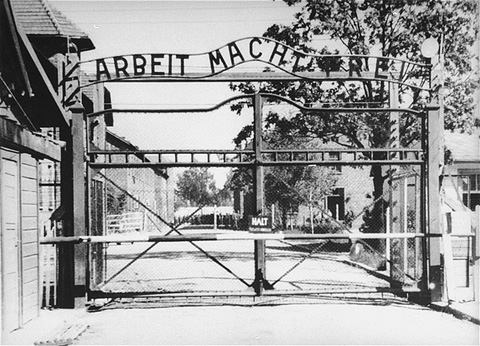 Hoess was relieved of his duties as Commandant of Auschwitz-Birkenau complex and sent to Oranienburg to replace Arthur Liebehenschel as the Senior Director of WVHA, the SS Economic Department. On December 1, 1944, Liebehenschel became the new Commandant of Auschwitz, but only the Auschwitz I camp, not the whole Auschwitz-Birkenau complex. Hoess was allegedly having an affair with a woman prisoner in Block 11 at the Auschwitz I camp. The woman, identified only as E.H., told her story to the American liberators at Dachau and it was included in a book entitled "Dachau Liberated, The Official Report by The U.S. Seventh Army." Dr. Georg Konrad Morgen, an SS judge who was assigned to investigate corruption in the Auschwitz camp, allegedly learned of the affair and fired Hoess from his position as Commandant of Auschwitz-Birkenau. The daughter of Arthur Liebehenschel wrote in a book entitled "My father, the Auschwitz commandant, published in 2009, that her father was demoted and sent to Auschwitz in 1944 because he had left his wife for another woman who was friendly with Jews. According to Danuta Czech, who wrote "The History of KL Auschwitz," published in 1967, the administration of the three camps that comprised the vast Auschwitz complex was divided among three different Commandants on November 22, 1943. The original Auschwitz I camp was put under the command of Liebehenschel while Auschwitz II (Birkenau) was placed under the command of SS Major Fritz Hartjenstein, who was later transferred to Natzweiler and then to Ravensbrück. SS 2nd Lt. Hans Schwarzhuber was put in charge of the men's camp at Birkenau and SS 2nd Lt. Franz Hössler was put in charge of the woman's camp. Hans Schwarzhuber, who was transferred to Ravensbrück on January 12, 1945, was put on trial in a British military court at Hamburg after the war. Schwarzhuber confessed that prisoners were gassed at Ravensbrück and at Birkenau. He was convicted of war crimes and executed on May 3, 1947. Franz Hössler (sometimes spelled Hoessler) was later transferred to Bergen-Belsen where he stayed behind to assist the British when the camp was voluntarily turned over to them on April 15, 1945. Hössler was put on trial by the British in the Belsen trial in 1945. He was convicted of war crimes committed at Birkenau and was hanged on December 13, 1945. Auschwitz III (Monowitz) was put under the command of SS 2nd Lt. Heinrich Schwartz in November 1943. In his autobiography, published under the title "Death Dealer," Hoess wrote this about Commandant Schwartz: Schwartz always stubbornly demanded that the prisoners be treated decently, be given good food and have adequate shelter. He moved quickly and often drastically against those responsible where there were legitimate complaints, and he didn't rest until the grievance was remedied. On May 8, 1944, Liebehenschel was transferred to Lublin to become the Commandant of the Majdanek death camp, according to Danuta Czech. After Majdanek was evacuated just before it was liberated by the Soviet Union in July 1944, Liebehenschel was sent back to Oranienburg. He was arrested by the American military after the war and was extradited to Poland for trial; he was convicted of war crimes by a Polish court and was executed on January 24, 1948. On May 5, 1944, Richard Baer became the Commandant of the Auschwitz main camp, according to Danuta Czech. Baer is often referred to as the "last Commandant of Auschwitz," but he was only in charge of the Auschwitz main camp, not the whole Auschwitz complex. In January 1945, Baer replaced Otto Förschner as the Commandant of Mittelbau-Dora, the concentration camp in Germany where the V-2 rockets were built. After the war, Richard Baer escaped justice by hiding under an assumed name while he worked as a lumberjack in a remote area in Germany. He was finally tracked down and arrested in 1960, soon after Adolf Eichmann was captured in Argentina where he was also hiding under an assumed name. Baer was asked to give a deposition which was entered into the trial of Eichmann in Israel. Baer was awaiting his own trial in the Auschwitz case in Frankfurt when he mysteriously died in prison just before the trial began in June 1963. Under interrogation, Baer had stubbornly refused to admit to the gassing of prisoners at Auschwitz. On May 8, 1944, Rudolf Hoess was brought back to Auschwitz to be the commander of the SS garrison and to oversee the gassing of the Hungarian Jews, according to Danuta Czech. In January 1941, all the Nazi concentration camps were designated as Class I, Class II or Class III camps. The Auschwitz main camp, called KL Auschwitz, was designated a Class I camp, meaning a mild prison for political dissidents who were considered capable of being "rehabilitated." The Auschwitz main camp was a place where the political prisoners had such amenities as a swimming pool, a brothel, a library, several orchestras, a theater and a museum where their artwork was displayed. The barracks in the main camp were brick buildings with flush toilets, porcelain-covered stoves and double-paned casement windows. There was also a hospital where Otto Frank, the father of Anne Frank, stayed for three months because he was suffering from exhaustion. Otto Frank had himself voluntarily checked into the hospital, by a Dutch doctor, who was an inmate himself. The photo below shows one of the Auschwitz orchestras, conducted by Franciszek Nierychlo. The orchestra members were inmates in the camp. An orchestra was stationed near the camp entrance so that the prisoners could hear classical music as they marched in and out of the camp. On Sundays, there were concerts which the prisoners and the SS staff members attended together. 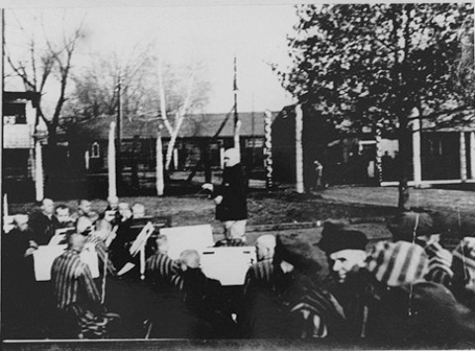 Another orchestra, consisting of 54 female prisoners, played at Birkenau for a year and a half; this was the only female orchestra commisioned by the SS during World War II. After the orchestra leader, Alma Rosé, died in October 1944, the other 53 women were sent to Bergen-Belsen where all of them survived. Anita Lasker Wallfisch played the cello in the women's orchestra. In an interview in 2008, Wallfisch told a reporter that she survived Auschwitz because she was in the orchestra: "As long as they wanted an orchestra, they couldn't put us in the gas chamber. That stupid they wouldn't be, because we are not really replaceable. Somebody who carries stones is replaceable." A few prisoners were saved at Auschwitz because they had other skills that could be used for the amusement of the SS officers. Salamo Arouch was a boxing champion in his home town of Salonika in Greece before he was transported to Auschwitz in 1943. He escaped the gas chamber because he was selected to fight in boxing matches twice a week for the entertainment of the German officials at Auschwitz. In 1989, a movie called "Triumph of the Spirit" was made about his harrowing ordeal as a prisoner at Auschwitz. Arouch died in 2009 at the age of 86. According to the Auschwitz Museum, the first prisoners to be gassed at Auschwitz were 600 Soviet Prisoners of War and 250 sick prisoners who were killed with Zyklon-B gas on September 3, 1941 in Cell No. 27 in Block 11, the prison block in the main Auschwitz camp. Commandant Rudolf Hoess was not there when the first gassing took place in the Auschwitz main camp. Peter Padfield, the biographer of Himmler, wrote that while Hoess was away, "his deputy, SS Hauptsturmführer Karl Fritzsch, decided to experiment with a prussic acid gas called Zyklon-B that was stored in the camp in crystal form for use against vermin." According to Padfield, the experiment was a success and "Höss told Eichmann about it when he next visited the camp." Karl Fritzsch was the first Lagerführer (camp leader) of the Auschwitz main camp; he was transferred to the Flossenbürg concentration camp in December 1941 and replaced by Hans Aumeier. According to Jeremy Dixon who wrote the book entitled "Commanders of Auschwitz," Aumeier was dismissed from his job at Auschwitz by Reichsführer-SS Heinrich Himmler and sent to several other camps, ending his career at a camp in Norway. After the war, Aumeier did not try to hide; he was arrested in June 1945 and was originally slated to be tried by an American Military Tribunal for crimes committed at Dachau, but instead, he was extradited to Krakow to be tried along with other members of the Auschwitz staff. Aumeier was convicted and hanged in January 1948. The first gas chamber, that was used at the Auschwitz-Birkenau complex, was in a room that was being used as a morgue in Krema I, the crematorium in the main camp. The gas chamber in Krema I was only used between September 1941 and March 1942, according to the Auschwitz Museum, although the ovens were used for cremation until 1943. Jews were gassed in Krema I only during a six-week period in 1942; the rest of the time, it was used for gassing Soviet Prisoners of War. According to Jean-Claude Pressac, who wrote a book entitled "Auschwitz: Technique and Operation of the Gas Chambers," there was a total of approximately 10,000 people gassed in Krema I, which had a capacity of 600 to 800 persons for each gassing. By the end of March 1942, the gassing operation was moved to the Auschwitz II camp, also known as Birkenau. Two old farm houses at the western end of the Birkenau camp were used for gassing while four new gas chambers were under construction. By the time that the Soviet liberators arrived on January 27th, the gas chamber in Krema I at the main camp had been converted into a bomb shelter in the fall of 1944. In 1947, when the Auschwitz camp became a Museum, the Krema I gas chamber was reconstructed according to the descriptions given by the survivors. Two of the three ovens were reconstructed from parts found in the camp. However, visitors to Auschwitz were told for 50 years that the reconstructed gas chamber was original. Auschwitz II - aka BirkenauGassing of the Gypsies at BirkenauZyklon-B used for gassing at BirkenauSelection for the gas chamber or laborAuschwitz III - aka MonowitzMonowitz gas chamber?Liberation of Auschwitz-BirkenauSurvivors of Birkenau campDeath StatisticsBack to Auschwitz-Birkenau Articles indexHomeThis page was last updated on February 03, 2010 |